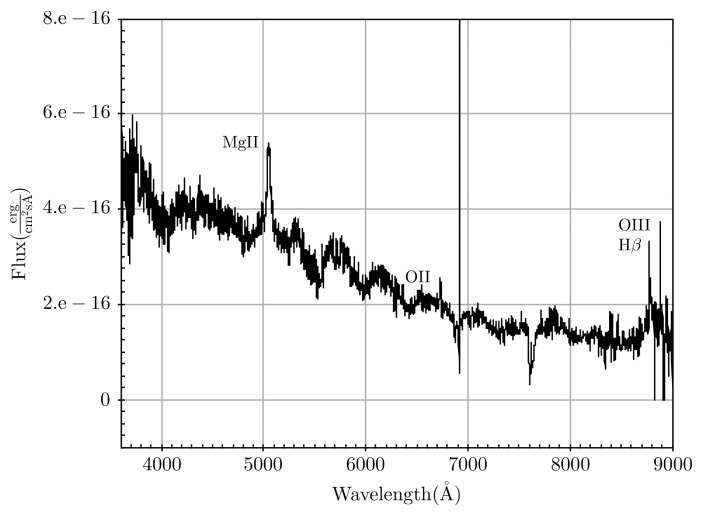September 19, 2017 report
New quasar discovered by astronomers

(Phys.org)—A team of astronomers led by Jacob M. Robertson of the Austin Peay State University in Clarksville, Tennessee has detected a new quasi-stellar object (QSO). They found the new quasar, designated SDSS J022155.26-064916.6, as a result of an analysis of available spectroscopic data. The finding is reported in a paper published Sept. 10 on the arXiv pre-print server.
QSOs are active galactic nuclei of very high luminosity, emitting electromagnetic radiation observable in radio, infrared, visible, ultraviolet and X-ray wavelengths. They are among the brightest and most distant objects in the known universe, and serve as fundamental tools for numerous studies in astrophysics as well as cosmology. For instance, quasars have been used to investigate the large-scale structure of the universe and the era of reionization. They also improved our understanding of the dynamics of supermassive black holes and the intergalactic medium.
To date, astronomers have identified more than 200,000 quasars, most of them from the Sloan Digital Sky Survey (SDSS). SDSS is an imaging and spectroscopic redshift survey, which utilizes the 2.5-m wide-angle optical telescope at the Apache Point Observatory (APO) located in New Mexico. It is regarded as one of the most successful astronomical surveys, having produced the most detailed three-dimensional maps of the universe ever made.
Now, a group of researchers led by Robertson reports the discovery of another quasar from the SDSS data. They found that the object known as SDSS J022155.26-064916.6, which was initially imaged by SDSS and classified as a star with a cosmic ray hit, is in fact a quasar at redshift of about 0.8.
The discovery is the result of observations conducted by the team in December 2013 using APO's Dual-Imaging-Spectrograph (DIS) on the 3.5m ARC telescope. The true nature of this object was uncovered by reducing its spectrum, which was part of the program supporting photometric calibrations for the Dark Energy Survey (DES). DES is an international near-infrared survey. Its main goal is to probe the dynamics of the expansion of the universe and the growth of large-scale structures in search of important information about the mysterious phenomenon of dark energy.
"We report the discovery of a new quasar: SDSS J022155.26-064916.6. This object was discovered while reducing spectra of a sample of stars being considered as spectrophotometric standards for the Dark Energy Survey," the astronomers wrote in the paper.
According to the study, SDSS J022155.26-064916.6 has a luminosity of at least 19 trillion solar luminosities. The quasar's absolute magnitude was found to be about 28 and its luminosity distance was estimated to be approximately 16.7 billion light years away from the Earth.
The researchers also compared the properties of SDSS J022155.26-064916.6 to those of other quasars in SDSS's seventh major data release, known as Data Release 7 (DR 7). This comparison allowed them to conclude that the newly confirmed QSO does not differ much from other typical quasars reported in DR 7.
"We see that SDSS J022155.26-064916.6 is a fairly typical, moderately bright quasar," the astronomers concluded.
More information: Discovery of a New Quasar: SDSS J022155.26-064916.6, arXiv:1709.03166 [astro-ph.HE] arxiv.org/abs/1709.03166
Abstract
We report the discovery of a new quasar: SDSS J022155.26-064916.6. This object was discovered while reducing spectra of a sample of stars being considered as spectrophotometric standards for the Dark Energy Survey. The flux and wavelength calibrated spectrum is presented with four spectral lines identified. From these lines, the redshift is determined to be z is approximately equal to 0.806. In addition, the rest-frame u-, g-, and r-band luminosity, determined using a k-correction obtained with synthetic photometry of a proxy QSO, are reported as 7.496 ×1013 solar luminosities, 2.049 ×1013 solar luminosities, and 1.896×1013 solar luminosities, respectively.
Journal information: arXiv
© 2017 Phys.org



















